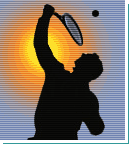|
Home >> Physical Workshops >>
 Tennis Anyone?: What to do About Tennis Elbow Tennis Anyone?: What to do About Tennis Elbow
by Chris Kushner
You have a mega-volley going and you're driving your opponent all over the court with your returns. Finally, you smash a winning shot right past him and it's game, set, and match. But the next morning, your arm is aching. What could it be? Well, you just might be suffering from tennis elbow. Here's all you need to know about this common sports injury.
What exactly is tennis elbow? Tennis elbow is another term for epicondylitis, which is an inflammation of either muscles, tendons or bursa and one or both of the epicondyles. The epicondyles are bony prominences where the muscles of the forearm attach (by tendons) to the upper arm bone (the humerus).
Do only tennis players get tennis elbow? No, but it is very common among tennis players, racquet sport players, and golfers because of the strenuous forearm activity of these sports.
What are the causes of tennis elbow? There are a number of causes, such as a sudden snapping of the wrist (a tennis serve or golf swing, for example); chronic stress on muscles and tendons from gripping too much, too hard, or incorrectly; and gripping or swinging objects (club or racquets) that are too heavy. Any of these may lead to an inflammation or partial tear of tendons or muscles in the elbow and forearms.
How do you know if you have tennis elbow? There are a lot of different types of elbow pain associated with different injuries, but if you are suffering from a weak grip, or you have pain when twisting the hand or wrist (such as using a screwdriver), then you probably have it.
The pain may be more persistent and annoying rather than sudden and severe. If the pain is predominately on the outside of the elbow, it is probably tennis elbow. Pain on the inside is commonly referred to as golfers elbow. Epiconylitis usually develops gradually over time and may come and go. If the problem persists, call your doctor.
How do you care for tennis elbow? Always consult your physician first. You may also find physical therapy helpful. Common treatment for tennis elbow is usually moist heat or ultrasound. But it may take several months to recuperate, depending on the severity of the inflammation and each individual's recovery rate. In more severe cases, immobilization (forearm splints) may be needed.
A physical therapist may also recommend that you perform rehabilitation exercises to restore the range of motion and strength in the joint and muscles. Your doctor may suggest a corticosteroid injection to reduce pain and swelling, but repeated injections may weaken muscles and tendons to the point of rupture. If epiconylitis is not properly taken care of, it may lead to a complete tear of ligaments, muscles, or tendons.
Helpful Hints
Keep forearm muscles strong with a sound resistance-training program. There are several exercises that can help do the trick.
- Grab a tennis ball or handball and squeeze it as hard as you can for 5 seconds. Repeat two to three times.
- Hold a hammer in the injured hand with your arm bent in front of you. Point the hammer up to the ceiling and down to the floor with just your wrist doing the movement. Repeat 10 times.
- Rest your forearm across a table, bench or chair with your hand just off the edge in a hitch-hiker position. Slowly turn your thumb out away from the body until the palm is facing up, and then slowly bring the thumb back up towards the ceiling. You can hold a weighted object if you can tolerate the pain. Repeat five to 10 times.
Warm up before you exercise or play sports. You may warm up by doing the exercises cited above, or just by easing your way into your activity. For example, if you're going to play tennis you can warm up by gently swinging the racquet without hitting any tennis balls for about 5 minutes. Then gradually swing harder and have someone volley with you, gradually increasing the velocity and force of your swing.
If you are developing the symptoms of tennis elbow, stop playing and consult a physician. If your doctor decides you can still play, just try to limit your playing time. For instance, you can play for 10 minutes, and then rest for 10 minutes, then play again for 10 minutes, and rest again for 10 minutes, and so on. If the pain is still persistent then it is recommended that you stop playing for a few weeks or until your physician gives you the OK to resume.
Chris Kushner is the director of specialized fitness services at cyfit.com and has more than 10 years of industry experience.

back |
top
|
